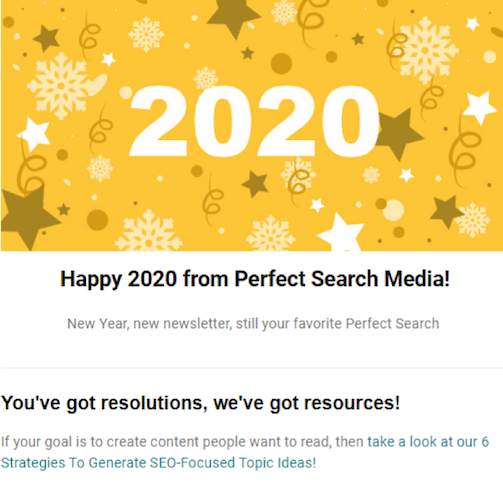

Updated February 27, 2020
A new year requires new, fresh content. Revamp your content strategies from last year with these five tips on how to take your content to the next level.
Content is king when it comes to connecting with your audience. Having well-considered content, whether it’s a blog post, tweet, or newsletter, is paramount if you’re hoping to reach viewers. Even more, you’ll be more likely to inspire action in your readers if you produce content they want and need to read.
With the turn of the new year, there’s no time left for clunky and uninspiring content. Here’s a guide to step up your content game so you can start the year on the right foot.
Looking for a Content Marketing agency?
Compare our list of top Content Marketing companies near you
If you grew up in the ‘90s or prior, you likely experienced flipping through thousands of pages in an encyclopedia, looking for the answer to a question or for more information about a thought that crossed your mind.
Thanks to the internet, we can save time page-turning with a quick Google search. Content creators have the opportunity to deliver query answers in new and exciting ways — and consumers are expecting this, too.
If you’re looking to deliver fresh content through text, you may want to consider writing the following types of content.
Blogs are one of the most popular ways to deliver information to your reader.
Blog posts are a great way to win answer boxes or fill content gaps. You can jam a great deal of information into a long or short-form post that aligns directly with your reader’s search intent.

By creating data and research-driven content, your blog could become the source people trust to get their information, setting you up as a resource for users over time.
When imagery and words team up, you get a brilliant infographic.
If your goal is to quickly teach something to your reader or simplify information into its most important parts, an infographic might be the best choice. Readers can be a little word-shy, and an infographic can be an inviting tool to grip readers and make the text feel more approachable.
Nobody likes to go on vacation and realize they’ve forgotten their *insert important thing here.* Content works the same way.
Just as a blog post or infographic can make you an authority on a given topic, a checklist is a fabulous way to be your reader’s prepared friend — the friend, if you’re me, who won’t let you go on vacation without your trusty SPF 15 lip balm.
Sometimes, companies seem like impenetrable powerhouses because we don’t get to meet the people who make them run so seamlessly or aren’t acquainted with the products that have catapulted them to the top. An interview or Q&A with a team member can help your reader become more familiar with who you are and what you bring to the table.
Furthermore, this helps breathe humanity into your figureheads and invites consumers closer to your product or company.
Case studies are documents that both showcase and digest work you have done to reach a certain goal.
They highlight the methodology, successes, shortcomings, and figures of your work. Moreover, they’re great to use with your clients to show them what you’ve been working on and what you and your team are capable of.
Newsletters offer a friendly way to pop in on those interested in your site and company. A newsletter provides more information and briefs readers on changes that are taking place in your neck of the woods.

With the help of a great designer, you can make newsletters that readers look forward to and, perhaps, enjoy with an espresso and biscotti.
Perhaps the swiftest and easiest way to generate quick, short, and sweet content is through a tweet, Facebook status, or social media platform of your choosing.
Adding an image, GIF, or meme will ensure you’re creating something shareable, too.
People today are exposed to an estimated 5,000 ads every day. You want to make sure the ads your company uses yield your intended goal, be it clicks, downloads, purchases, etc.
Great ad copy will inspire your readers to take action.
If you’re looking for more creative ways to generate content that’s a little less “writerly,” you may want to consider:
If you’re already in the business of creating content, be sure you’re tracking its progress and performance. Generating content is just the very beginning. You want to make sure that your content is serving you for as long as possible following its upload.
Here are some questions to ask as you assess your content’s performance:
What are the views month-over-month and year-over-year?
Let’s go a step further and think about what happens after you’ve tackled these questions. Use that information to inform your next steps. Hone in on what your best content is doing, and compare and contrast this with your content that’s not doing so hot. Create some next steps for how you can reorient your content so that it’s performing based on user preferences.
A single piece of content should have more mileage following its posting. Answering these questions can help you plan a roadmap for generating and extending the lifespan of your content.
Search engine optimization is a practice that ensures the right content reaches the right user — that is, content that serves the user/searcher’s intent is landing on the first page of the search engine results page (SERP) for easy access to searchers.
With the direction of search, your content needs to have an SEO focus to make sure that what you’re creating is reaching the right people. It’s not enough to just have content. Your content needs to be optimized, too.
Content can be optimized in myriad of ways including on- and off-page SEO, metadata optimization, and re-optimizing old content. It’s also important to keep up-to-date with changes happening to the SEO landscape, such as Google's E.A.T guidelines, BERT, etc.
The closer your content makes it to the first page on the SERP, the more impressions your site and posts will garner.
As mentioned previously, other opportunities to optimize your content from an SEO perspective include:
From a technical SEO perspective, you’ll also want to make sure that your website speed is fast, your content isn’t leading your searchers to 404 errors, and that your website is providing a smooth user experience (UX). All of this is the brilliant work of SEO experts.
All in all, SEO is a fantastic tool, and you don’t want to miss out on the ways it could help bring what you offer to who needs it — or better yet, who didn’t know they needed you in the first place.
A no-brainer in content is to have good, legible, and quality content. Some best practices include looking out for:
Your reader is not interested in puzzling why something is constructed the way it is. In fact, we can assume they don’t care and they certainly did not arrive at your blog post or video to ascertain this fact — that is unless this is the topic of your post.
Think about content like a Goldilocks and The Three Little Bears situation. Save Goldi and your readers the trouble and make sure what you’re creating is “just right.” If your content doesn’t make sense or doesn’t seem like a considered choice, then make a different decision.
There are many reasons why content may not be getting made and all of those are fine but no reason not to get going on this endeavor. If you’re having a hard time getting started, find a content marketing expert.
There are content mavens, SEO geniuses, and ad copy enthusiasts roaming this earth who want to work with you. They’ve got ideas for how to generate the best, data-driven content for your needs.
The most important thing in creating a successful content strategy is to start now.
Think about your company, organization, association, and/or brand. Think about your audience and who you want to reach. Gather a team of people, and make it happen today.
Content begins with you, and great content comes with practice, a team of brilliant minds, and this little guide to get you started.


